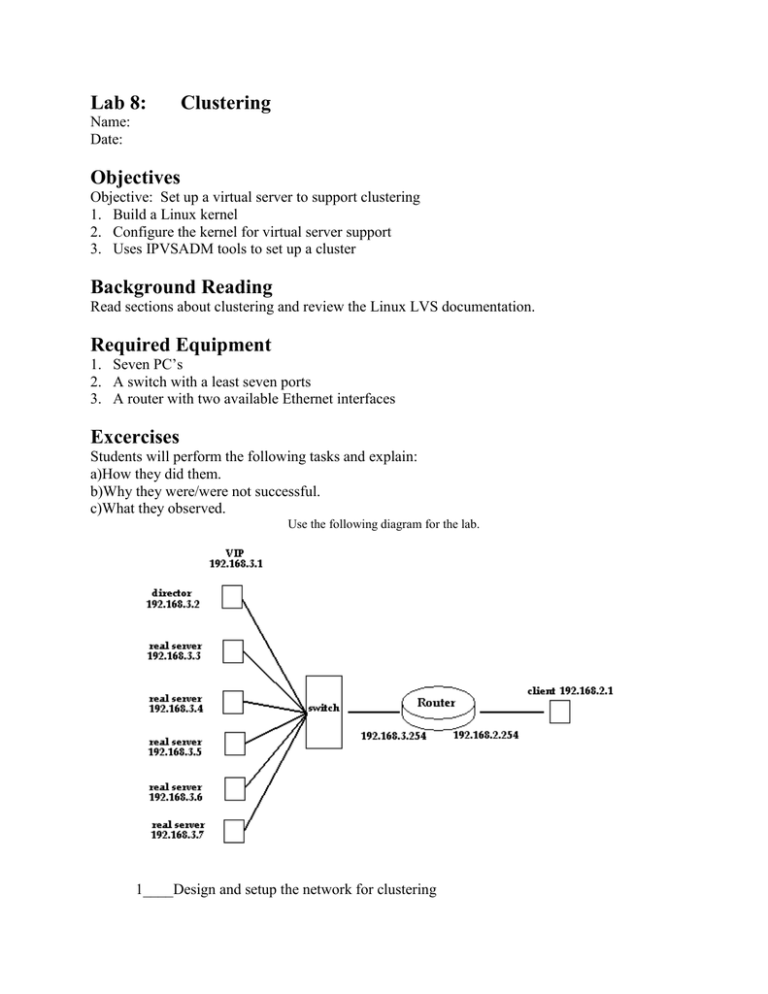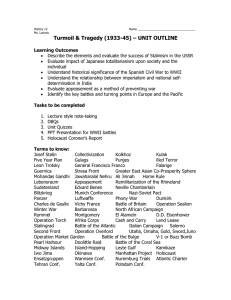Lab 8: Clustering Objectives
advertisement

Lab 8: Clustering Name: Date: Objectives Objective: Set up a virtual server to support clustering 1. Build a Linux kernel 2. Configure the kernel for virtual server support 3. Uses IPVSADM tools to set up a cluster Background Reading Read sections about clustering and review the Linux LVS documentation. Required Equipment 1. Seven PC’s 2. A switch with a least seven ports 3. A router with two available Ethernet interfaces Excercises Students will perform the following tasks and explain: a)How they did them. b)Why they were/were not successful. c)What they observed. Use the following diagram for the lab. 1____Design and setup the network for clustering a. Follow the diagram to set up the network. b. Reconfigure the router interfaces. c. Configure the client host machine interface. 2____Retrieve the kernel and necessary patches a. copy and untar the tarred kernel file to /usr/src b. make a symbolic link to the new kernel directory c. copy the kernel patches to /usr/src/linux d. apply the patches patch -p1 < linux-2.4.18-ipvs-1.0.2.patch (do not apply the hidden patch on the director) patch -p1 < hidden-2.4.5-1.diff e. Configure the kernel for ipvs by selecting the following menu items root# make menu config 1. 2. 3. 4. 5. f. file system support EXT3 network support Ethernet 10/100 3COM 3C590 or 3C900 network options add everything network filter connection tracking add everything virtual server configuration add everything Build the kernel using the following commands root# make dep root# make clean root# make bzImage root# make modules root# make install g. Modify the bootloader to use the new kernel on reboot root# root# root# root# root# cp linux/arch/i386/boot/bzImage /boot cd /boot rm vmlinuz mv bzImage bzImage-2.4.19 ln -s bzImage-2.4.19 vmlinuz h. Edit the menulist for grub with the following changes root# vi /boot/grub/menulist kernel vmlinuz root = /dev/hda2 (remove the initrd line) i. Reboot the machine root# reboot 3____Install and configure ipvsadm tools a. Copy the ipvsadm tools to /usr/src b. Change directories to ipvsadm root# cd ipvsadm c. Install ipvsadm root# make install d. Copy the real server script to /root on all real servers root# cp lvs-rsv3.conf /root e. Copy the virtual server script to /root on the director root# cp lvs-d.conf /root f. LVS-D.CONF #!/bin/bash Edit the server scripts accordingly #---------------mini-rc.lvs_dr-director-----------------------#set ip_forward OFF for vs-dr director (1 on, 0 off) /sbin/ifconfig eth0 192.168.3.2 broadcast 192.168.3.255 netmask 255.255.255.0 /sbin/route add -host 192.168.3.2 dev eth0 echo "0" > /proc/sys/net/ipv4/ip_forward #director is not gw for realservers: leave icmp redirects on echo 'setting icmp redirects (1 on, 0 off) ' echo "1" > /proc/sys/net/ipv4/conf/all/send_redirects cat /proc/sys/net/ipv4/conf/all/send_redirects echo "1" > /proc/sys/net/ipv4/conf/default/send_redirects cat /proc/sys/net/ipv4/conf/default/send_redirects echo "1" > /proc/sys/net/ipv4/conf/eth0/send_redirects cat /proc/sys/net/ipv4/conf/eth0/send_redirects /sbin/ifconfig eth0:1 192.168.3.1 broadcast 192.168.3.1 netmask 255.255.255.255 /sbin/route add -host 192.168.3.1 dev eth0:1 /sbin/route add default gw 192.168.3.254 dev eth0 #setup_ipvsadm_table #clear ipvsadm table /sbin/ipvsadm -C #installing LVS services with ipvsadm #add telnet to VIP with round robin scheduling /sbin/ipvsadm -A -t 192.168.3.1:http -s rr #forward http to realserver using direct routing with weight 1 /sbin/ipvsadm -a -t 192.168.3.1:http -r 192.168.3.3 -g -w 1 /sbin/ipvsadm -a -t 192.168.3.1:http -r 192.168.3.4 -g -w 1 /sbin/ipvsadm -a -t 192.168.3.1:http -r 192.168.3.5 -g -w 1 /sbin/ipvsadm -a -t 192.168.3.1:http -r 192.168.3.6 -g -w 1 #displaying ipvsadm settings /sbin/ipvsadm #not installing a default gw for LVS_TYPE vs-dr #---------------mini-rc.lvs_dr-director------------------------ LVS-RSV3.CONF #!/bin/bash #----------mini-rc.lvs_dr-realserver-----------------#installing default gw 192.168.3.254 for vs-dr /sbin/ifconfig lo 127.0.0.1 broadcast 127.255.255.255 netmask 255.0.0.0 /sbin/ifconfig eth0 192.168.3.6 broadcast 192.168.3.255 netmask 255.255.255.0 /sbin/route add default gw 192.168.3.254 #checking if DEFAULT_GW 192.168.3.254 is reachable ping -c 1 192.168.3.254 #set_realserver_ip_forwarding to OFF (1 on, 0 off). echo "0" > /proc/sys/net/ipv4/ip_forward cat /proc/sys/net/ipv4/ip_forward #looking for DIP 192.168.1.9 ping -c 1 192.168.3.2 #looking for VIP (will be on director) ping -c 1 192.168.3.1 #install_realserver_vip /sbin/ifconfig lo:1 192.168.3.1 broadcast 192.168.3.1 netmask 255.255.255.255 #ifconfig output /sbin/ifconfig lo:1 #installing route for VIP 192.168.3.1 on device lo:1 /sbin/route add -host 127.0.0.1 dev lo /sbin/route add -host 192.168.3.1 dev lo:1 #hiding interface lo:1, will not arp echo "1" > /proc/sys/net/ipv4/conf/all/hidden cat /proc/sys/net/ipv4/conf/all/hidden echo "1" > /proc/sys/net/ipv4/conf/lo/hidden cat /proc/sys/net/ipv4/conf/lo/hidden #----------mini-rc.lvs_dr-realserver------------------ g. Stop the network root# /etc/init.d/network stop h. Start the LVS scripts root# /root/lvs-d.conf (on director) root# /root/lvs-rsv3.conf (on real servers) i. Create a text file on each host to reflect host information root# ifconfig eth0 > /var/www/html/text.txt j. Test cluster by repeatedly accessing the cluster site and viewing the text.txt file.






